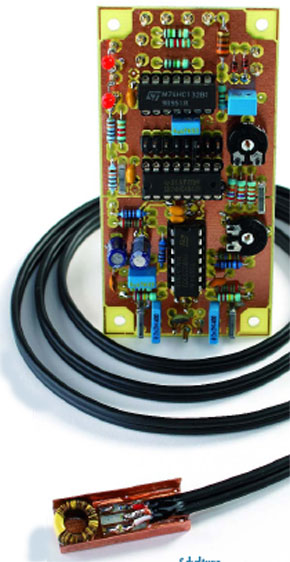Article
Find the Fault
Audible short-circuit finder

Even the most experienced electronics engineer will undoubtedly come across these: short-circuits in places where they don’t belong. And they naturally occur at times when they’re least welcome. For those who are tired of scanning around a PCB with a magnifying glass, we present here a handy circuit that makes searching for short-circuits on homemade PCBs or already assembled boards a piece of cake.
Materials
Gerber file
CAM/CAD data for the PCB referred to in this article is available as a Gerber file. Elektor GREEN and GOLD members can exclusively download these files for free as part of their membership. Gerber files allow a PCB to be produced on an appropriate device available locally, or through an online PCB manufacturing service.
Elektor recommends the Elektor PCB Service service from its business partner Eurocircuits or AISLER as the best services for its own prototypes and volume production.
The use of our Gerber files is provided under a modified Creative Commons license. Creative Commons offers authors, scientists, educators and other creatives the freedom to handle their copyright in a more free way without losing their ownership.
PCB
Component list
Resistors
R1,R2 = 220k
R3 = 470
R4,R5,R9 = 20k0
R6,R8,R10 = 1k00
R7 = 17k4
R11,R12 = 100k
R13 = 1M
R14,R16 = 1k2
R15 = 150
R17,R18 = 27k
R19 = 12k
R20 = 68
P1 = 5k linear law mono potentiometer, small model
P2,P3 = 5k preset
Capacitors
C1 = 100pF
C2,C3 = 1nF8 MKT
C4,C5 = 2nF2 MKT
C6,C7 = 22pF
C8,C10 = 470nF
C9,C11 = 1nF MKT
C12 = 1µF MKT, lead pitch 5 or 7.5mm
C13,C14,C17,C18 = 100nF ceramic
C15,C16 = 100µF 10V radial
Inductors
L1 = 35 mH, 100 turns 0.1 mm ECW on Ferroxcube core TL10/6/4-3E5 (Farnell # 3056960) or 92 turns 0.1 mm ECW on Epcos core B64290-L38-X38 (Schuricht # 331648)
L2 = 330µH
Semiconductors
D1,D2 = LED, low-current
D3,D4 = BAT85
IC1 = TS924IN (ST), rail-to-rail I/O (Schuricht # 648226)
IC2 = 74HC132
IC3 = 74HC4040
Miscellaneous
J1 = 16-way pinheader, 1 jumper
BZ1 = AC buzzer
BT1,BT2 = 1.5-V battery with holder
Double-pole switch (power on/off)
PCB, ref. 050313-1 from The PCBShop
R1,R2 = 220k
R3 = 470
R4,R5,R9 = 20k0
R6,R8,R10 = 1k00
R7 = 17k4
R11,R12 = 100k
R13 = 1M
R14,R16 = 1k2
R15 = 150
R17,R18 = 27k
R19 = 12k
R20 = 68
P1 = 5k linear law mono potentiometer, small model
P2,P3 = 5k preset
Capacitors
C1 = 100pF
C2,C3 = 1nF8 MKT
C4,C5 = 2nF2 MKT
C6,C7 = 22pF
C8,C10 = 470nF
C9,C11 = 1nF MKT
C12 = 1µF MKT, lead pitch 5 or 7.5mm
C13,C14,C17,C18 = 100nF ceramic
C15,C16 = 100µF 10V radial
Inductors
L1 = 35 mH, 100 turns 0.1 mm ECW on Ferroxcube core TL10/6/4-3E5 (Farnell # 3056960) or 92 turns 0.1 mm ECW on Epcos core B64290-L38-X38 (Schuricht # 331648)
L2 = 330µH
Semiconductors
D1,D2 = LED, low-current
D3,D4 = BAT85
IC1 = TS924IN (ST), rail-to-rail I/O (Schuricht # 648226)
IC2 = 74HC132
IC3 = 74HC4040
Miscellaneous
J1 = 16-way pinheader, 1 jumper
BZ1 = AC buzzer
BT1,BT2 = 1.5-V battery with holder
Double-pole switch (power on/off)
PCB, ref. 050313-1 from The PCBShop



Discussion (0 comments)